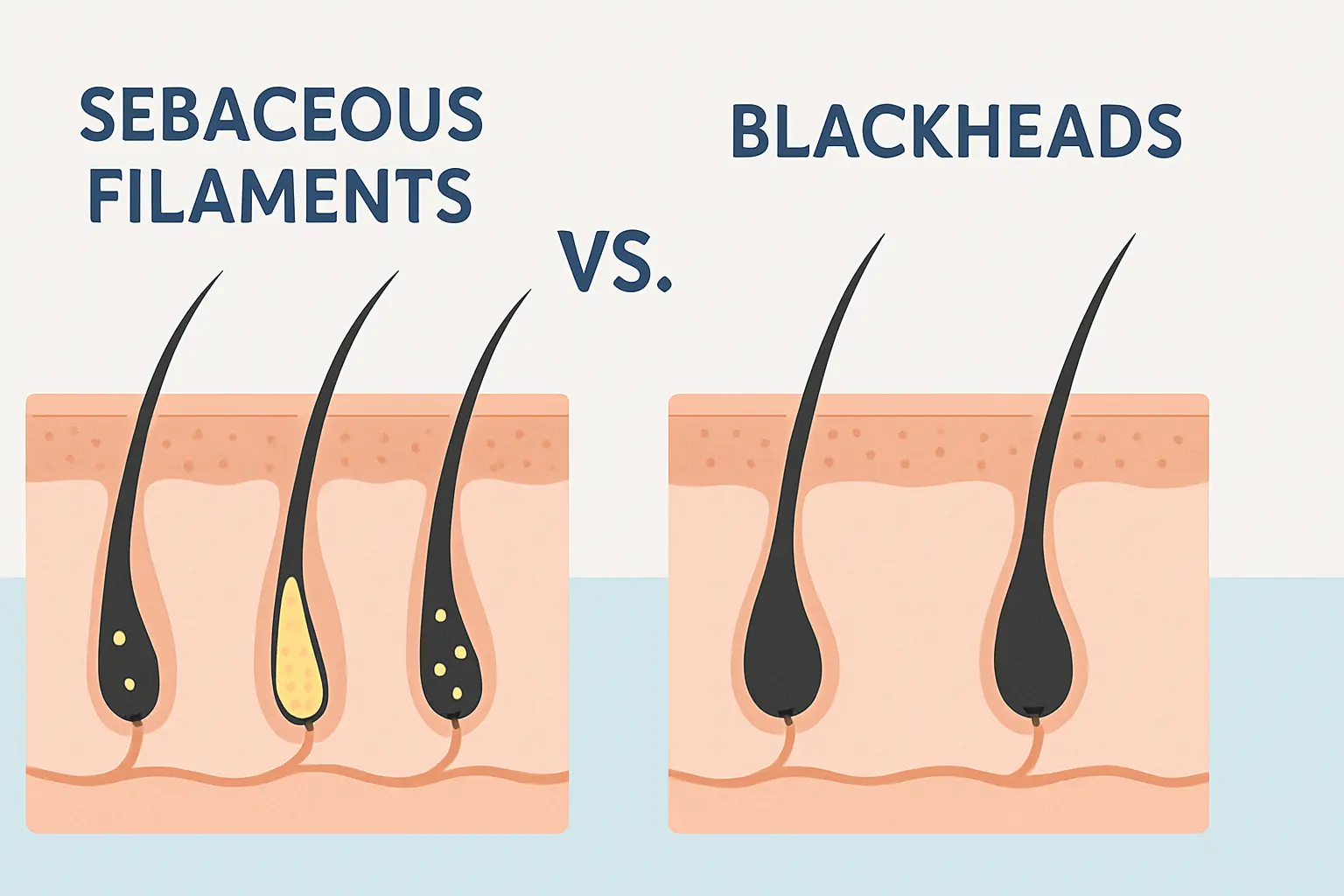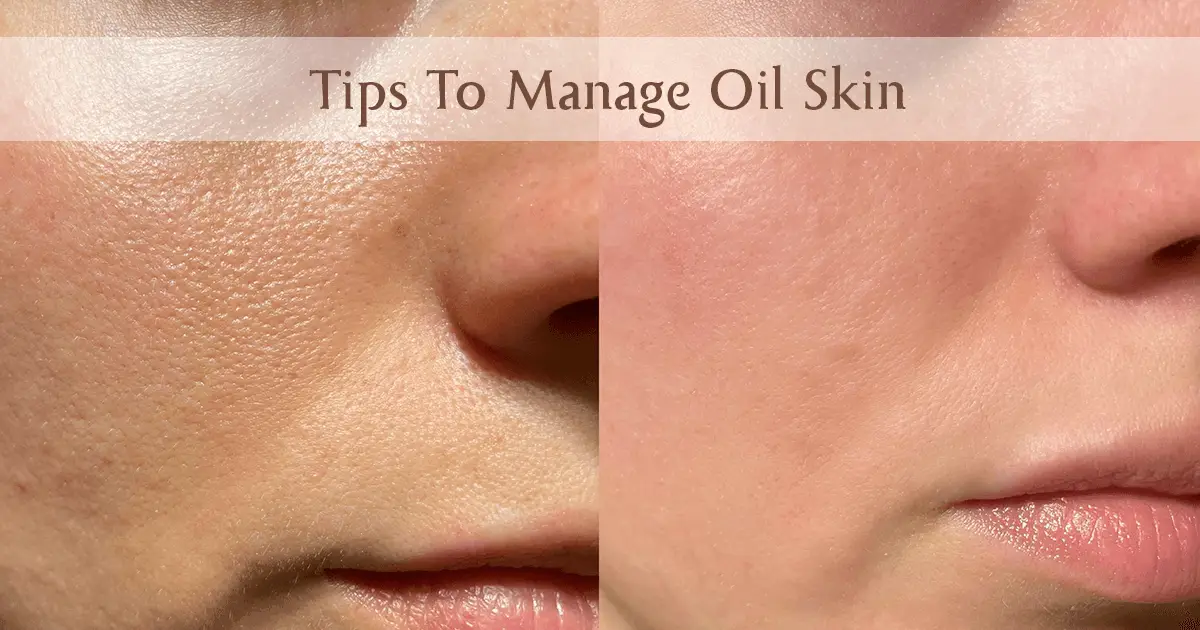
Ever looked in the mirror, seen those tiny little brown specks on your nose, and thought—ew, blackheads? You're not the only one. It's a common skincare myth, particularly with all the nose strip videos on social media that go viral, claiming to be pulling them out.
But the truth is, most of what gets pulled out from the surface of the nose isn’t blackheads—it’s something called sebaceous filaments. They may look alike, but they are entirely different. So, to avoid any confusion between the two, we’re here to clear things up and help you understand how to take care of each one the right way.
What Are Sebaceous Filaments?
Sebaceous filaments are tiny, threadlike structures that naturally line the inside of skin pores. They’re filled with sebum (your skin’s natural oil), dead skin cells, and a bit of bacteria. The sebaceous gland helps sebum to travel to the surface of the skin to keep it moisturised.1
You’ll mostly notice them on the nose, chin, and forehead and also where the skin tends to be more oily. They appear as small grey, light brown and yellow dots. Unlike blackheads, sebaceous filaments don’t block the pores or cause inflammation. Most importantly, they’re not a skin problem; in fact, they’re a completely normal part of your skin.1
Sebaceous Filaments Vs Blackheads
Now that you know what sebaceous filaments are, let’s take a closer look at the difference between the two. Here’s a quick overview of both:1 2
|
Sebaceous Filaments |
Blackheads |
|
They are light grey, brown, or yellow, and have a threadlike structure. |
They are open bumps on the skin due to clogged hair follicles. |
|
They are filled with sebum and dead skin cells. |
They are clogged pores due to excess oil, bacteria, and buildup. |
|
They appear on the nose, forehead, and chin (the T zones). |
They appear on the nose, T-zone, back, and chest. |
|
They are normal and do not require treatment unless they become bothersome. |
They require treatment as they can become inflamed or infected. |
Who Is More Prone To Sebaceous Filaments?
Sebaceous filaments are a natural part of the skin, but some factors can make them more visible, like:
- Age - During your teenage years, your skin produces more oil, making sebaceous filaments more visible. And as you grow older, your skin starts to lose firmness and pores may enlarge, which can make these filaments appear more prominent.1
- Skincare Habits - When you overwash your face or expose yourself to too much sun without protection, it can lead to dryness. And due to this, the oil glands of the skin may produce more sebum to compensate, making sebaceous filaments look more visible.1
- Hair Type - People with naturally thicker or denser hair follicles may see more visible sebaceous filaments, especially around the nose and T-zone.1
Tips To Manage Sebaceous Filaments
As we’ve already mentioned, sebaceous filaments are a natural part of your skin, so drying them out or trying to squeeze them won’t help. Your skin needs its natural oils to stay healthy!
That said, you can manage and reduce their appearance by treating the skin with the same care you’d give to oily skin. Here’s how:
1) Gentle Exfoliation
Regular exfoliation helps keep pores clear and prevents the buildup of dead skin cells. But be gentle! Always make sure to use a gentle exfoliant to avoid drying out your skin and to prevent further irritation.1
2) Keep Skin Moisturised
It might seem odd, but oily skin needs moisture too!2 When your skin is dehydrated, it can produce more oil, making sebaceous filaments more visible. And for this reason, you should opt for a lightweight, non-comedogenic moisturiser with ingredients like Hyaluronic acid or Glycerin. These ingredients can help skin retain moisture without clogging pores. 3 4
3) Avoid Squeezing
We get it—whether it’s a breakout or just a tiny dot on your face, the urge to squeeze is real. But always remember, squeezing sebaceous filaments won’t make them go away permanently. In fact, it could damage your skin, stretch out the pores, or even lead to inflammation. Instead, focus on the right products and routine to keep the pores looking cleaner and less noticeable.1
4) Apply Sunscreen
Extreme sun exposure can dull your skin or even damage it. 1 And that’s absolutely true. If you already have acne blemishes or visible sebaceous filaments, sun exposure can make them appear more prominent and darker. That’s why it’s always recommended to apply sunscreen before stepping out in the sun (or even when you’re indoors), since UV rays can penetrate through windows too.1 5
5) Use Over-The-Counter Creams
If those tiny filaments on your nose still bother you, many over-the-counter creams can help manage their appearance. Ingredients like Salicylic Acid work by gently exfoliating and keeping the pores clear, while retinoids support skin regeneration and prevent buildup.1
The key is to use your skincare products regularly. Don't rush to overdo the skincare regime. Also, if you're new to any of the above ingredients, it's a good idea to ease into them slowly to avoid any irritation.
Next, let's dive into how to effectively deal with blackheads.
Ways To Treat Blackheads
Blackheads may be stubborn, but with the right steps, you can manage and reduce them effectively. Here's what can help:2
- Wash your face twice daily! Clean, moisturised skin helps prevent excess sebum buildup, dirt accumulation, and keeps blackheads at bay.
- Use over-the-counter products containing Salicylic acid or benzoyl peroxide to gently clear pores and reduce blackheads.
- In many cases, doctors may recommend treatments like chemical peels and laser skin resurfacing to help get rid of stubborn blackheads.
- Also avoid touching your face too often, as it can transfer oils and dirt, which can worsen the blackheads.
- Stick to your skincare routine! Being consistent is what really makes the difference with your skin problems, including blackheads.
Our Recommended Product
When dealing with blackheads or sebaceous filaments, it’s easy to forget that hydration plays a big role. Over-cleansing or using harsh products can strip the skin, often triggering more oil production. Instead, it’s better to use products that offer long-lasting hydration while supporting your skin’s natural balance.
That’s where AreoVeda’s Clear Skin Duo can help. This combo features a gentle foam face wash and a skin clarifying serum that delivers 24 to 72 hours of hydration, helps fight acne-causing germs, and soothes dry, itchy, or sensitive skin. It's especially useful if you’re experiencing both oiliness and the occasional dryness or irritation.
The Final Say..
At the end of the day, your skin just wants to be understood and cared for, not stressed out. With gentle skincare habits and a little patience, you can manage sebaceous filaments and blackheads without harsh treatments. Keep things simple, stay consistent, and let your natural glow shine through.
FAQs
Q1) Do Pore Strips Remove Sebaceous Filaments?
Pore strips can pull out surface dirt like blackheads and sebaceous filaments. But removing sebaceous filaments can dry out your skin. So it's best to avoid them pulling away with pore strips.
Q2) When Should I Consult A Doctor About Sebaceous Filaments?
If sebaceous filaments cause persistent irritation, inflammation, or don’t improve with home care, it’s a good idea to see a healthcare provider. They can recommend treatments tailored to your skin needs.
Q3) Is It Okay To Pop Sebaceous Filaments?
Squeezing sebaceous filaments can damage the skin, enlarge pores, and cause irritation or infection. That is why it’s best to avoid popping and instead focus on gentle skincare to manage their appearance.
Q4) Does Salicylic Acid Treat Sebaceous Filaments?
Yes, salicylic acid gently exfoliates and cleanses pores, reducing the appearance of sebaceous filaments.











